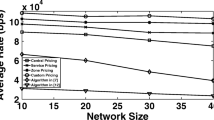Abstract
Non-orthogonal multiple access (NOMA) is a part of 5th generation (5G) communication systems. This article presents the underpinnings and underlying structures of the problem of NOMA user-channel allocation. Unlike the heuristics for NOMA user-channel allocation, the presented results are guaranteed to converge to a solution. In addition, the solutions are stable. More specifically, the deployment of results to cellular vehicular communication systems is shown as a use case of 5G technology in smart transport. Generally, the results apply to any NOMA system. Unlike the orthogonal frequency division multiple access resource allocation problem, the core matching is not the solution to NOMA resource allocation. The conditions under which the fix-point NOMA resource allocation is guaranteed to be stable from the viewpoint of both the base station and the NOMA users are described. In addition, relationships of NOMA user-channel resource allocation to game models and subgame perfect Nash equilibria are elucidated.



Similar content being viewed by others
References
“3GPP TR 36.885, study on LTE-based V2X services (Release 14), 3GPP Technical Specification Group Radio Access Network, v14.0.0,” Technical Report, (2016)
A. Papathanassiou and A. Khoryaev, Cellular V2X as the essential enabler of superior global connected transportation services. IEEE 5G Tech Focus, Vol. 1, No. 2, p. 1, 2017.
Z. Ding, X. Lei, G. K. Karagiannidis, R. Schober, J. Yuan, and V. K. Bhargava, A survey on non-orthogonal multiple access for 5G networks: Research challenges and future trends, IEEE Journal on Selected Areas in Communications, Vol. 35, No. 10, pp. 2181–2195, 2017.
B. Di, L. Song, Y. Li, and Z. Han, V2X meets NOMA: Non-orthogonal multiple access for 5G-enabled vehicular networks, IEEE Wireless Communications, Vol. 24, No. 6, pp. 14–21, 2017.
L. Dai, B. Wang, Y. Yuan, S. Han, I. Chin-Lin, Z. Wang, Non-orthogonal multiple access for 5G: Solutions, challenges, opportunities, and future research trends. IEEE Communications Magazine, Vol. 53, No. 9, pp. 74–81, 2015
B. Klaus and M. Walzl, Stable many-to-many matchings with contracts, Journal of Mathematical Economics, Vol. 45, No. 7, pp. 422–434, 2009.
J. W. Hatfield and P. Milgrom, Matching with contracts, American Economic Review, Vol. 95, No. 4, pp. 913–935, 2005.
F. Echenique and J. Oviedo, A theory of stability in many-to-many matching markets, Theoretical Economics, Vol. 1, No. 2, pp. 233–273, 2006.
A. E. Roth, Stability and polarization of interests in job matching, Econometrica, Vol. 52, No. 1, pp. 47–58, 1984.
M. Sotomayor, Three remarks on the many-to-many stable matching problem, Mathematical Social Sciences, Vol. 38, pp. 55–70, 1999.
E. Rasmusen, Games and information: An introduction on Game Theory. Basil Blackwell, New York, 1989.
R. Gibbons, An introduction to applicable game theory, Journal of Economic Perspectives, Vol. 11, No. 1, pp. 127–149, 1997.
F. Echenique and J. Oviedo, Core many-to-one matchings by fixed-point methods, Journal of Economic Theory, Vol. 115, No. 2, pp. 358–376, 2004.
Acknowledgements
This work was supported in part by the State of California SB1 2017/2018 through the Trustees of the California State University (Agreement #ZSB12017-SJAUX) and the California State University Transportation Consortium and in part by the NSF Award ECCS-1642536.
Author information
Authors and Affiliations
Corresponding author
Additional information
Publisher's Note
Springer Nature remains neutral with regard to jurisdictional claims in published maps and institutional affiliations.
Rights and permissions
About this article
Cite this article
Sodagari, S. Underpinnings of User-Channel Allocation in Non-orthogonal Multiple Access for 5G. Int J Wireless Inf Networks 29, 365–372 (2022). https://doi.org/10.1007/s10776-022-00569-4
Received:
Revised:
Accepted:
Published:
Issue Date:
DOI: https://doi.org/10.1007/s10776-022-00569-4



